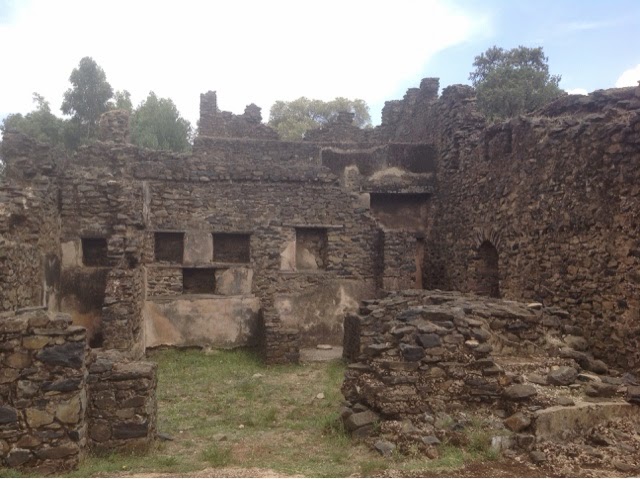This first photo is the original castle built by Fasil around 1638. To emphasize the Ethiopian royal family's connection to Israel by way of King Solomon, The Queen of Sheba and their son, Menelik I, the castle walls are adorned with the Star of David, which became the official symbol of Ethiopia after the Solomonic dynasty reclaimed the throne in the 13th century.
This castle was built by Fasil's son Yohannis I (1667-1682). During the Italian Occupation in the late 1930s, the original stone structure was covered in plaster to make it look more "Italian". It certainly makes it look less "Ethiopian".
Yohannis I was succeeded by his brother, Emperor Iyasu (1682-1706), who is regarded as the greatest ruler of the Gondar period. This is what's left of the (at one time) very ornate castle. Some of the damage was caused by a strong earthquake in 1704, but most of the damage was caused by British bombing during WWII because the Italians had their military headquarters within the compound.
A view of Yohannis I's castle through a doorway in Iyasu's castle.
Each of the six castles were connected either by bridges or tunnels. This shows the bridged connection between Fasil's castle and Iyasu's castle.
This is actually not a castle, although it looks like one. This structure served as The Royal Archive Building. King Fasil and his successors had maticulous records kept of the empire's activities.
In 1699, Iyasu was visited by a French doctor named Poncet. After treating Iyasu for a skin ailment and syphillis, Iyasu commissioned the construction of a "clinic" adjacent to his castle, complete with a multi-chamber sauna and jacuzzi bath. The ruins clearly show the shelves where medicines were kept.
Dawit III was poisoned in 1721 and his brother Bakafa took the throne and ruled for 9 years. Bakafa was not a popular ruler, so not much is known about him. When he died his 8 year old son, Iyasu II (1730-1755), was next in line. Deemed too young to be a King, he ruled under the regency of his mother, Mentewab. The last castle built within the compound (below), Mentewab's Castle, was constructed on behalf of Iyasu II.
Four kings were crowned and assassinated in the 15 years after Iyasu was ousted. Only one of them, Iyasu's son Dawit III (1716-1721), left his mark by building a lion cage. He kept black-maned Abysinnian lions as pets. Lions were kept in these cages continuously until the last one died in 1992. Dawit III also built a concert hall, below.









No comments:
Post a Comment